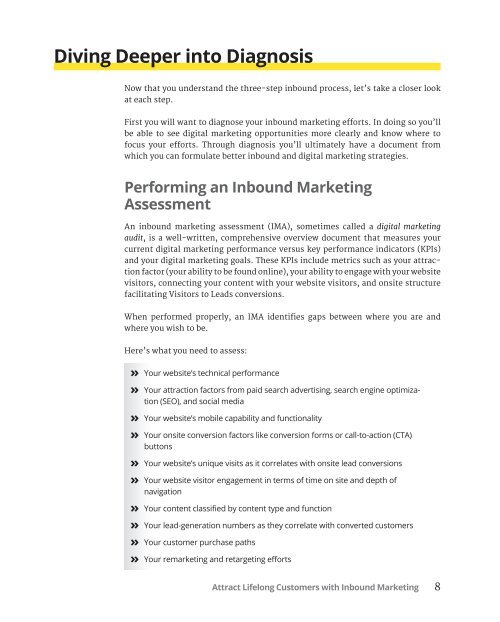Dummies Marketing
Dummies MarketingDummies MarketingDummies MarketingDummies MarketingDummies MarketingDummies MarketingDummies MarketingDummies MarketingDummies MarketingDummies MarketingDummies Marketing
Dummies MarketingDummies MarketingDummies MarketingDummies MarketingDummies MarketingDummies MarketingDummies MarketingDummies MarketingDummies MarketingDummies MarketingDummies Marketing
Create successful ePaper yourself
Turn your PDF publications into a flip-book with our unique Google optimized e-Paper software.
Diving Deeper into Diagnosis<br />
Now that you understand the three-step inbound process, let’s take a closer look<br />
at each step.<br />
First you will want to diagnose your inbound marketing efforts. In doing so you’ll<br />
be able to see digital marketing opportunities more clearly and know where to<br />
focus your efforts. Through diagnosis you’ll ultimately have a document from<br />
which you can formulate better inbound and digital marketing strategies.<br />
Performing an Inbound <strong>Marketing</strong><br />
Assessment<br />
An inbound marketing assessment (IMA), sometimes called a digital marketing<br />
audit, is a well-written, comprehensive overview document that measures your<br />
current digital marketing performance versus key performance indicators (KPIs)<br />
and your digital marketing goals. These KPIs include metrics such as your attraction<br />
factor (your ability to be found online), your ability to engage with your website<br />
visitors, connecting your content with your website visitors, and onsite structure<br />
facilitating Visitors to Leads conversions.<br />
When performed properly, an IMA identifies gaps between where you are and<br />
where you wish to be.<br />
Here’s what you need to assess:<br />
»»<br />
Your website’s technical performance<br />
»<br />
» Your attraction factors from paid search advertising, search engine optimization<br />
(SEO), and social media<br />
»»<br />
Your website’s mobile capability and functionality<br />
»»<br />
Your onsite conversion factors like conversion forms or call-to-action (CTA)<br />
buttons<br />
»»<br />
Your website’s unique visits as it correlates with onsite lead conversions<br />
»»<br />
Your website visitor engagement in terms of time on site and depth of<br />
navigation<br />
»»<br />
Your content classified by content type and function<br />
»»<br />
Your lead-generation numbers as they correlate with converted customers<br />
»»<br />
Your customer purchase paths<br />
»»<br />
Your remarketing and retargeting efforts<br />
Attract Lifelong Customers with Inbound <strong>Marketing</strong> 8




